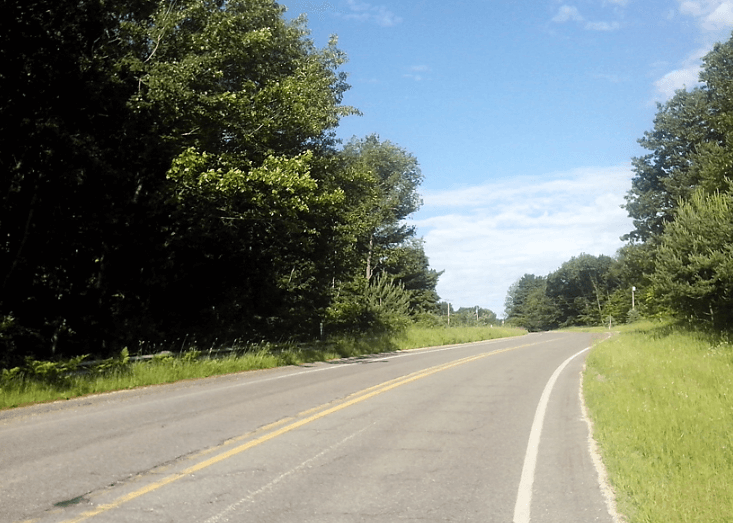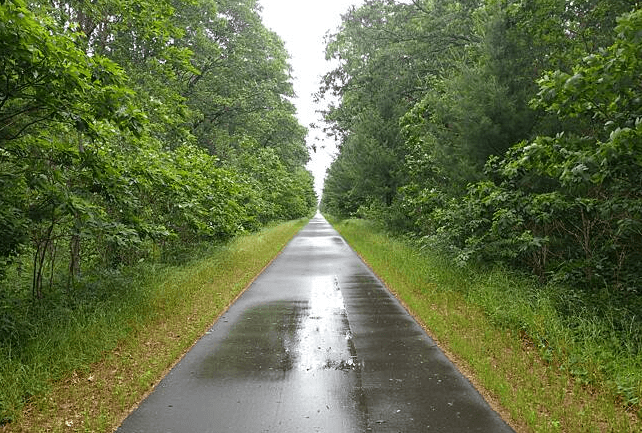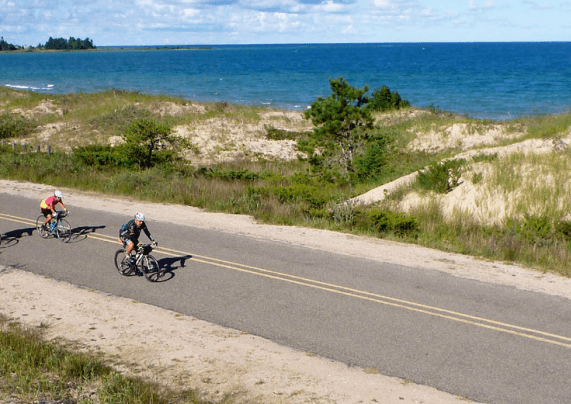From seasoned cyclists to families looking for a picturesque ride in the great outdoors, the Hart Montague Bike Trail is a gem in the heart of West Michigan. Whether you’re inspired by the wonders of nature or the thrill of pedaling through vibrant communities, this trail has something for everyone. With over 22 miles of smooth asphalt, this charming pathway invites riders to experience history, wildlife, and the laid-back charm of rural Michigan. In this comprehensive guide, we will take you through the trail and all the highlights you can expect along the way, ensuring your biking adventure is one to remember.
Exploring Nature Along the Trail
A Scenic Journey Through West Michigan
The path from Muskegon to Montague takes you through some of Michigan’s most stunning natural landscapes. The trail is a tapestry of woodlands, wetlands, and agricultural fields, offering a constantly changing backdrop as you ride. Enjoy the vibrant wildflowers that bloom throughout the seasons, watch for birds and other wildlife, and take in the refreshing scents of the forest. This section of the state is also known for its picturesque lakes, which you can catch glimpses of at various points along the trail.
The Flora and Fauna of Mason County
Mason County, through which the trail winds, is a haven for biodiversity. Keep your eyes peeled for the elusive white-tailed deer, wild turkey, and the occasional fox. The trail’s various ecosystems make it an excellent place for birdwatching. In the wetlands, you might spot a blue heron gracefully stalking its prey, or in the fields, a red-tailed hawk soaring high above. The rich soil and ample rainfall in this region also support a variety of trees, including maple, oak, and beech; enhancing your biking experience with shady canopies and vibrant autumnal hues.
A Ride Through History
Oceana County’s Timeless Tales
The Hart Montague Trail offers more than just a scenic route; it provides a unique opportunity to travel through history. Take a detour to the ghost town of Shelby, a community that once thrived on the logging industry. The trail also passes by the White River Light Station, an iconic landmark that has stood sentry over Lake Michigan since 1875, guiding sailors safely to the harbor. There’s a tangible sense of the past along this trail, and these historic sites offer a chance to step back in time and imagine the region as it once was.
The Montague Area’s Heritage and Culture

The charming town of Montague, the trail’s terminus, is a perfect example of the enduring culture of the region. The town’s founder, William Montague, laid the first railroad in town in 1872, ushering in a new era of prosperity. Montague’s rich history is reflected in its well-preserved downtown, Victorian-era homes, and the Montague Area Public Museum, where you can further explore the area’s heritage. The town also boasts a vibrant arts community, and if your visit coincides with the second Saturday of the month, you can experience the White River Gallery Walk, featuring the work of talented local artists.
Community Connections
Connecting With Local Culture
One of the greatest joys of a long bike ride is the opportunity to connect with local communities. Along the trail, you’ll pass through multiple townships, each with its own local charm and community spirit. Muskegon, where the trail begins, has a bustling downtown and is home to several museums, including the Muskegon Museum of Art and the USS LST 393 Veterans Museum. Here, you can sample local cuisine, visit farmers’ markets, and even catch a performance at one of the local theaters.
Festivals and Events Along the Trail
Make your visit to the Hart Montague Trail even more memorable by timing it with one of the many local festivals and events. Muskegon, for example, hosts the Unity Christian Music Festival, a Midwestern staple drawing in thousands of visitors every year. Montague and the neighboring city of Whitehall are famous for the annual White Lake Area Arts & Crafts Festival, featuring over 200 artists and artisans. These events showcase the vibrancy of the local culture and are a perfect way to conclude your biking adventure along the trail.
Trail Logistics and Useful Tips
Planning Your Ride
Before you set out on the Hart Montague Trail, it’s essential to plan your trip effectively. The trail is 22 miles one way, so whether you’re biking the full length there and back, or arranging transport at your endpoint, be sure to plan for the duration of your ride. Consider the weather, especially during Michigan’s variable seasons, and make sure to pack essentials such as water, sunscreen, and a first aid kit.
Trailside Amenities and Services
The Hart Montague Trail is well equipped with amenities along its route. You’ll find rest areas, picnic spots, and access to local businesses for food and supplies. There are also several bike rental shops in Muskegon and Montague, should you need to hire equipment. The trail has multiple access points, with parking areas available, offering flexibility for riders who want to tackle the trail in segments.
Safety and Etiquette on the Trail
Like all shared-use paths, the Hart Montague Trail has a set of rules and courtesies to ensure everyone’s safety and enjoyment. Keep to the right, pass on the left, and signal your intentions to prevent accidents. Be sure to respect the natural environment, stay on the designated path, and leave no trace of your visit. Safety first: wear a helmet, use lights if riding at dawn or dusk, and be mindful of your speed, especially in congested areas.
Further Explorations
The Hart Montague Trail is part of a larger network of paths and roads that crisscross West Michigan, offering adventure for cyclists of all levels. Consider extending your trip by exploring the nearby William Field Memorial Hart-Montague Trail State Park, or connecting to the existing Musketawa Trail for added miles and experiences. West Michigan is also home to a variety of other outdoor activities, from hiking and birding to water sports on the scenic inland lakes and Lake Michigan shore.
What is the longest bike path in Michigan?
The longest bike path in Michigan is the Iron Belle Trail, which is an ambitious project aiming to be one of the longest designated state trails in the United States. The Iron Belle Trail consists of two distinct routes covering more than 2,000 miles across Michigan. One path is dedicated to biking, stretching over 1,273 miles from Belle Isle Park in Detroit to Ironwood in the western Upper Peninsula. This sprawling network traverses a diverse array of landscapes, connecting numerous communities and offering cyclists a unique and extensive tour through the heart of Michigan’s natural and cultural landscapes.
7 Fascinating Facts About Michigan’s Bike Trails
- A Greener Ride: Michigan’s bike trails are part of the state’s efforts to promote eco-friendly transportation and recreation, reducing carbon emissions and encouraging a healthier lifestyle.
- Economic Boosters: These trails not only promote health and wellness but also significantly impact local economies, drawing tourists and cycling enthusiasts, which benefits small businesses and communities.
- Award-Winning Paths: The trails in Michigan have received national recognition for their quality, scenic beauty, and connectivity, with some being designated as Pure Michigan trails and others receiving Rails-to-Trails Conservancy honors.
- A Year-Round Adventure: While most popular in the warmer months, several of Michigan’s trails are groomed for winter activities, offering a unique experience for fat tire biking, snowshoeing, and cross-country skiing.
- Historic Routes: Many of Michigan’s trails are built on historical rail lines, providing a glimpse into the past as cyclists ride through historic towns, alongside old railways, and over bridges that have stood the test of time.
- Inclusive and Accessible: Efforts have been made to ensure these trails are accessible for individuals of all abilities, with smooth surfaces and gradual inclines, making it possible for more people to enjoy the beauty of Michigan outdoors.
- Wildlife Encounters: The natural settings of Michigan’s bike trails offer cyclists the chance to see a wide array of wildlife, from birds of prey overhead to the occasional deer or fox crossing their path, enhancing the connection to nature.
These insights into Michigan’s bike trails highlight the multifaceted benefits and experiences they offer, from boosting local economies and promoting sustainability to providing inclusive recreational opportunities in the beautiful Michigan outdoors.
In Summary
The Hart Montague Trail combines the best of natural beauty, history, and local culture, making it a must-visit destination for cyclists and outdoor enthusiasts. With careful planning and an open mind, this trail promises an unforgettable experience. Whether you’re gliding through the aspens in autumn, taking a refreshing spring ride, or enjoying the warmth of summer in the Midwest, the Hart Montague Bike Trail is the perfect way to immerse yourself in the splendors of Michigan. Pack your panniers, lube up your gears, and get ready to pedal through one of the Midwest’s most beloved biking routes.



